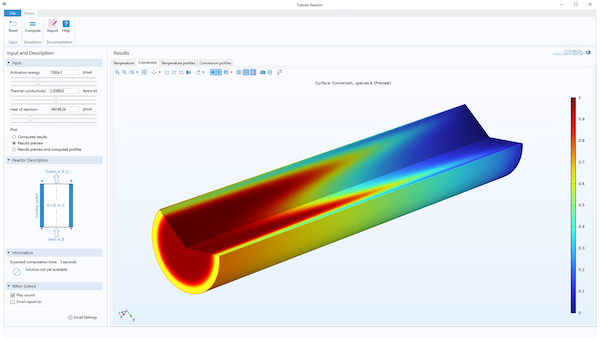COMSOL Releases Version 6.2 of COMSOL Multiphysics
The latest version of the multiphysics simulation software accelerates computations and introduces surrogate model functionality.

A propylene glycol reactor app that uses a surrogate model to provide instant solution updates and an interactive user experience. Image courtesy of COMSOL.
Latest News
November 20, 2023
COMSOL announced the release of COMSOL Multiphysics version 6.2, adding data-driven surrogate model functionality for efficient standalone simulation apps and multiphysics-based digital twins.
According to the company, it also features high-performance multiphysics solvers for the analysis of electric motors, up to 40% faster turbulent CFD simulations, and an order of magnitude faster impulse response calculations for room and cabin acoustics. Additionally, it is now up to seven times faster to perform boundary element analysis (BEM) for acoustics and electromagnetics when running on clusters.
Surrogate models deliver accurate simulation results faster than the full-fledged finite element models that they approximate, the company says. When used in simulation apps, this leads to near-instantaneous results, providing app users with an improved interactive experience. In addition, surrogate models are useful for digital twins, where fast and frequent updates of simulation results are often necessary.
The latest software version also introduces the ability to make simulation apps with automated updates through timer events, which COMSOL says can useful when creating digital twins or IoT-connected simulation apps.
“Surrogate models significantly strengthen the app-building capabilities in COMSOL Multiphysics®, and open up new possibilities to our users,” says Lars Langemyr, chief scientist at COMSOL. “They can now create effective digital twins and build interactive, computationally fast, and accurate standalone apps.”
High-Performance Multiphysics Simulations for Electric Motors
Version 6.2 expands the capabilities for efficient simulation of electric motors as well as for transformers and other electric machinery through a time periodic solver, available in the AC/DC Module. It also enables multiphysics motor analysis involving acoustics, structural mechanics, multibody dynamics, and heat transfer, and makes it possible to run optimization studies to find new motor designs.
“The new solving method makes an important class of electric motor simulations several orders of magnitude faster,” says Durk de Vries, technical product manager for the AC/DC Module at COMSOL. “It allows for efficient analysis of multiphysics phenomena that were previously out of reach. This is pivotal for electric motor design optimization, where a balance between structural, thermal, and electromagnetic objectives is essential.”
In addition, core offerings, like visualization and meshing, have been improved, and add-on products are expanded and updated, the company says. Version 6.2 also adds more than 100 new and updated example models, helping users enhance their modeling skills.
Some highlights from the broadened scope of physics modeling include:
- 7 turbulence models for high-Mach-number flow
- Realistic frequency-dependent materials for acoustics simulations in the time domain
- Modeling of hydrogen embrittlement in solids for fuel cells, electrolyzers, and corrosion
- Extended damage, fracture, and contact modeling
- Easy-to-use specific absorption computations for RF tissue simulations
- Analysis of light propagation through liquid crystals
- Ability to use local weather data for temperature and pressure in simulations, based on a GPS location
- The boundary element method, used here for a radar cross section computation, is now up to 7 times faster.
You can download the updated software here.
More COMSOL Coverage
Subscribe to our FREE magazine, FREE email newsletters or both!
Latest News





